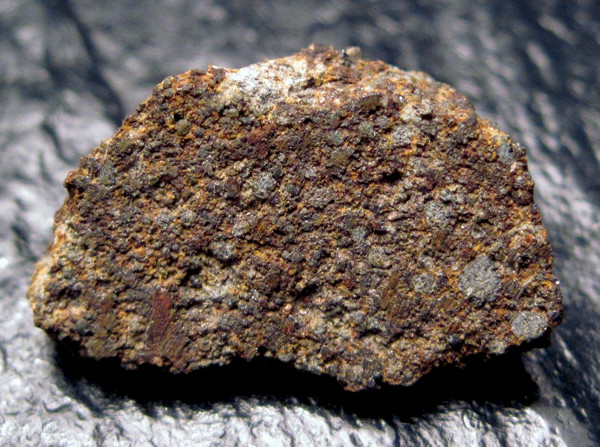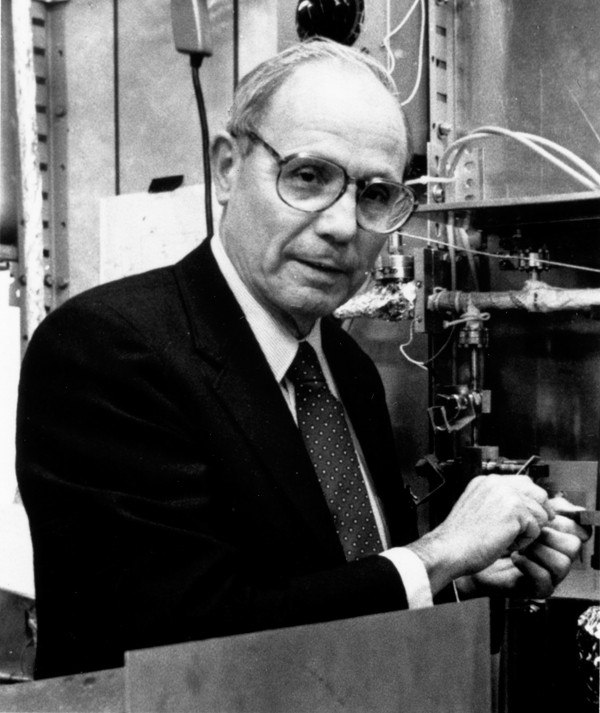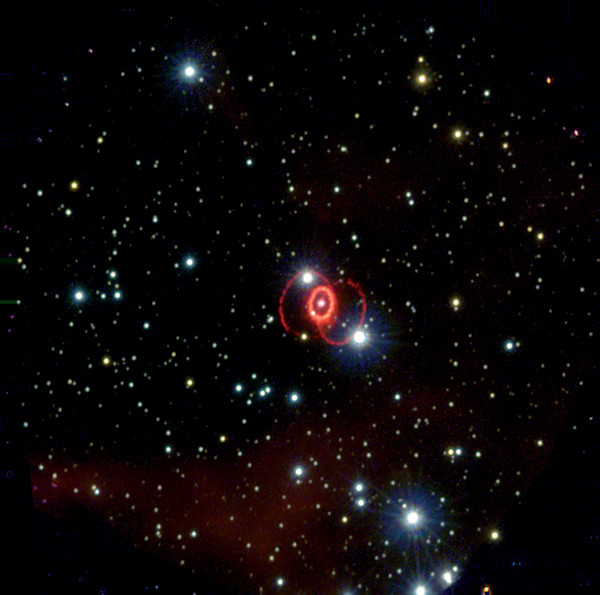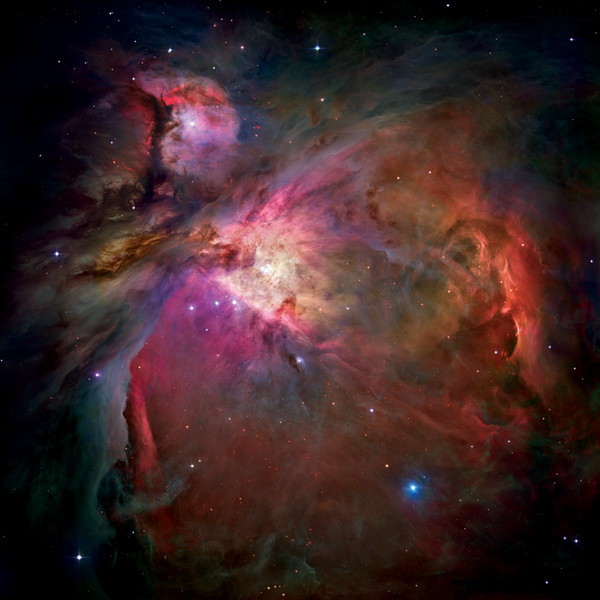
by Sara E. Pratt Friday, September 25, 2015

this 2.5-gram piece of the richardton meteorite hit a building in stark county, n.d., on June 30, 1918. pieces of the meteorite revealed the remnants of an extinct radioactive element that predates the formation of the solar system. Credit: Jon Taylor/Creative Commons Attribution-shareAlike 2.0 Generic.
On June 30, 1918, Leo Kern saw a fireball blaze across the sky above his farm near Richardton, N.D., lighting up the night sky as if it were daytime and then exploding with a deafening boom that shook houses and rattled windows. Kern ducked behind a telegraph pole as fragments that sounded like “whistling bullets” struck his barn, he later reported to geologist T.T. Quirke of the University of Minnesota. What Kern and other witnesses all over the southwestern corner of the state had seen was a 90-kilogram meteor entering Earth’s atmosphere and breaking up 100 kilometers above the surface. Kern had no way of knowing it at the time, but he had also witnessed the arrival of a message from the dawn of the solar system — one that scientists wouldn’t decode for another 42 years.
The meteor, later determined to be a chondritic, or stony, meteor, is estimated to have broken into about 200 pieces as it entered Earth’s atmosphere. By the late 1950s, at least one of those pieces had found its way to the lab of John Hamilton Reynolds in the Department of Physics at the University of California at Berkeley.
Reynolds had come to Berkeley from the University of Chicago, where he’d studied experimental mass spectrometry under many of the physicists who had helped develop the atomic bomb during World War II. After the war, the Manhattan Project scientists had turned their newfound knowledge of nuclear physics toward solving some of the biggest questions in astronomy, including the determination of the ages of the meteorites, Earth and the solar system.
Starting in the early 1940s, astronomers had begun to unravel the stellar life cycle and how solar systems, planets and elements form during that cycle. The so-called solar nebula theory holds that vast, cold clouds of interstellar gas and dust collapse, forming stars and all the other materials that surround them.
In the 1950s, the theory of stellar nucleosynthesis emerged, explaining how the heavy elements, from carbon to iron, are formed by nuclear reactions in the cores of stars and then dispersed upon their deaths. In the case of our solar system, astronomers posit that a supernova occurred in our celestial neighborhood just prior to the collapse, seeding the nebular cloud with heavy elements, and possibly, triggering the collapse itself.
Meanwhile, scientists were looking more at how they could use radioactive decay to determine the age of Earth and the solar system. Radioactive decay of uranium into lead was first observed early in the 20th century, and scientists quickly realized that comparing the relative amounts of the original radioactive element and its decayed daughter products produced a kind of radiometric clock. Over the next several decades, many researchers worked to perfect the technique as a dating method. In the mid-1950s, Clair Patterson at Caltech used the method to show that meteorites and the Earth were both roughly 4.55 billion years old.
Researchers knew the solar system had to be slightly older, but no one knew when the elements that make up everything in the solar system —all the meteorites, moons, planets and people — had formed.

physicist John hamilton reynolds (1923–2000) of the university of california at Berkeley became known as the "father of extinct radioactivities" after his 1960 discovery of excessive xenon-129 in meteorites. Credit: UC Berkeley Media relations.
Astrophysicists suspected, but could not yet prove, that the elements present in the nebular cloud were captured when the first solid grains condensed in the early solar system and were preserved in chondritic meteorites, which had remained relatively unaltered since their formation 4.55 billion years ago. What would be needed, suggested University of Chicago physicist Harrison Brown, was a way to detect the decay products of a short-lived radioactive element that had gone “extinct.”
Like a paleontologist piecing together the existence of an extinct animal from trace fossils like footprints or coprolites, the new nuclear geochemists of the early 1950s sought traces of radioactive elements that no longer exist. Their brief half-lives meant that, after a relatively short time, none of the original element remained; only its daughter elements were still around.
Iodine-129, an isotope of iodine with a half-life of 17 million years, is one such element; the trace that it left behind was xenon-129, a rare gas found only in trace amounts on Earth. Excessive amounts of the gas, however, were expected to exist in solar and terrestrial gas.
Other researchers had previously tried to identify excessive amounts of xenon-129 in chondritic meteorites, but the instruments at the time weren’t sensitive enough to detect it. One of the first projects Reynolds had undertaken after arriving at Berkeley as a new assistant professor in 1950, however, was the design of a special all-glass mass spectrometer, which made it possible to run gas samples through the instrument many times, increasing the odds of detection of rare gases like xenon-129 or other noble gases.

according to the theory of stellar nucleosynthesis, the violent explosive deaths of stars, such as supernova 1987a seen here, seed the universe with the heavy elements that make up stars, planets, moons, meteorites and people. Credit: P. Challis (Harvard-smithsonian Center for Astrophysics).
In 1959, using his new machine, Reynolds found what he was looking for: an excessive amount of xenon-129 in samples of the Richardton meteorite.
The discovery provided overwhelming evidence that now-extinct radioactive isotopes, in this case iodine-129, were once “alive” in meteorites. Furthermore, the fact that a short-lived element such as iodine became trapped in the Richardton meteorite indicated that meteorites had formed early in the history of the solar system; otherwise the iodine would have decayed entirely before the meteorite formed. Just a few hundred million years passed between the supernova and the solidification of the dust grains that formed the meteorite that — 4.55 billion years later — would disintegrate over Richardton, N.D., terrifying Leo Kern.
“Reynolds’ great discovery of excess amounts of xenon-129 isotopes within the trapped xenon gas required a special source of xenon-129 to have once existed in the meteorites,” says Donald D. Clayton, emeritus professor of physics and astronomy at Clemson University and a pioneer in the study of nucleosynthesis. Clayton worked at Caltech during this period and had on occasion discussed the xenon work with Reynolds. “By analyzing all possible known sources of xenon-129, Reynolds showed that the only workable source was radioactive iodine-129 in the meteorite at the time that it formed 4.55 billion years ago.”
The discovery, which Clayton calls a “bombshell,” was reported in a three-page paper in the journal Physical Review Letters on Jan. 1, 1960. “That discovery was revolutionary,” Clayton says. “It provided fresh evidence for the idea that existing atoms within our Milky Way galaxy had been created in stars that had ejected their matter into the interstellar gas of our galaxy.”
Unlike many scientific discoveries, the significance of this one was well understood at the time, Clayton says. “Geologists, planetary scientists and astrophysicists all recognized the stunning data” presented by Reynolds.
At Berkeley, Reynolds was elevated to full professor in 1961. In support of his promotion, he received letters from Harold Urey and Edward Teller (of Manhattan Project fame), who wrote, “One can point to one particular accomplishment in his investigation of the xenon content of meteorites … [which] has led to the most striking conclusions concerning the conditions under which our planetary system must have formed.” In 1968, he was elected to the National Academy of Sciences.

thousands of stars are forming in the orion nebula, a cloud of gas and dust much like the nebula in which our solar system formed. Credit: NASA, ESA, M. Robberto (Space Telescope Science Institute/ESA) and the Hubble space Telescope Orion Treasury project Team.
After his xenon work, Reynolds became known as the father of extinct radioactivities.
“Inspired by Reynolds’ pathbreaking find, other scientists began at once to search for other extinct radioactive nuclei,” Clayton says. “Today we have evidence of 10 different extinct radioactive nuclei in our solar system,” including iron-60, aluminum-26 and calcium-41. Each of those nuclei have different half-lives, form through different nucleosynthesis processes and have different extinct abundances, all of which “pose a theoretical puzzle to those who hope to understand their meaning,” Clayton adds. “Big lessons for the rate of star death prior to our formation lurk in the data, only partially understood.”
In a tribute to Reynolds, written after his death on Nov. 4, 2000, colleagues Bruce Bolt, Richard Packard, and P. Buford Price wrote, “The modern sciences of geochronology and nuclear cosmochronology grew in large part out of the work of Reynolds and his students.”
Reynolds’ nuclear geochemistry work led to major contributions in solving some of the other big earth science questions of the last half century. Prior to his xenon work, Reynolds had fostered key developments in the technique of potassium-argon dating, which allowed geologists to date younger rocks (those about a million years old) than could be dated using uranium-lead dating; the development helped put absolute ages on the geologic timescale.
Students in Reynolds’ lab later developed the technique of argon-argon dating, which was used to date ash layers at Olduvai Gorge, where fossils of early human ancestors had been found, and moon rocks brought back by Apollo astronauts. It also allowed marine geologists to date the paleomagnetic reversals found in seafloor samples, which helped prove the existence of seafloor spreading and ultimately led to the acceptance of the theory of plate tectonics.
© 2008-2021. All rights reserved. Any copying, redistribution or retransmission of any of the contents of this service without the expressed written permission of the American Geosciences Institute is expressly prohibited. Click here for all copyright requests.